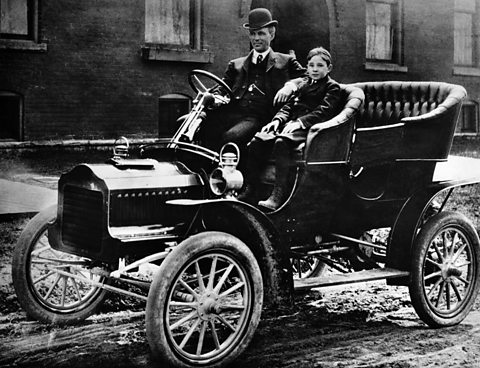The economic boom and the end of prosperity
The United States of America had an essential supply of natural resources such as timber, iron, coal, minerals, oil and land. This enabled America to become a huge economic power at the beginning of the 20th century. These resources were an important foundation for the economy.
Systems of hire-purchase and credit were introduced in order to help American people to purchase the new goods. As a result, the majority of Americans could afford expensive goods. In order to encourage Americans to take advantage of the scheme, advertisements were placed on roadsides, on the radio, in newspapers, catalogues and in cinemas. During the 1920s the electricity industry experienced a huge boom. By 1929 the majority of houses in America had electricity and 70 per cent of them used it for lighting purposes, and for new household goods.

Henry Ford mass produced affordable cars for the people of America by introducing the assembly line in his factories. By 1925 the price of a car was around $290, which was much cheaper than the price of $850 in 1908. By 1929 Americans owned 23 million cars. The workers earned good wages ($5 per day), thousands of jobs were created. Roads and petrol stations were built, as were hotels and restaurants.
The United States was led by three Republican presidents during the 1920s - Warren Harding, Calvin Coolidge and Herbert Hoover. The policy of these Republican presidents was that government should leave the economy alone – they adopted a laissez-faire (free market) policy. Their belief was that big businesses would be free to expand without being held back by the government.
There were many long-term reasons for the end of prosperity. By the end of the 1920s there were too many consumer goods unsold in the USA. As farming techniques improved, farmers started producing too much food. In response to the Fordney-McCumber Tariff Act, European countries had imposed a tax on American goods. After 1926, house prices fell leaving a number of Americans owning houses that were worth less money than what they had paid for them. There were no large banks in America. The small banks did not have the financial resources to cope with the rush for money when the Wall Street Crash happened.
Not everyone was rich in America during the 1920s. Some people benefitted from the boom - but some did not. Farmers were producing too many crops and couldn't sell them. Black people suffered economically, especially in the southern states, where segregation was in effect. Many immigrants had not been educated and were willing to work in any kind of job for very low wages. The traditional industries failed to respond to the new mass production methods of the 1920s.
Long-term reasons
There were many long-term reasons for the end of prosperity. By the end of the 1920s there were too many consumer goods unsold in the USA. As farming techniques improved, farmers started producing too much food. In response to the Fordney-McCumber Tariff Act, European countries had imposed a tax on American goods. After 1926, house prices fell leaving a number of Americans owning houses that were worth less money than what they had paid for them. There were no large banks in America. The small banks did not have the financial resources to cope with the rush for money when the Wall Street Crash happened.
Short-term reasons
The end of prosperity was also caused by short-term factors. Throughout the 1920s the prices of shares had increased to unrealistic levels. People continued to buy shares as they were making huge profits from them. Some people would buy shares on the margin - ie, borrowing money to buy shares. Many people started feeling nervous and investors went into panic and rushed to sell their shares. On 24 October 1929, 12.8 million shares were sold. On 29 October 1929, 16 million shares were sold at very low prices. The Stock Market in New York had collapsed.
The Roaring Twenties came to a sudden end. Many banks closed, ordinary people lost their savings and people lost all hope for the future. People could no longer buy consumer goods like cars and clothes. As a result, workers were made redundant, other workers' wages were cut and unemployment rose to very high levels. This was the start of The Great Depression of the 1930s.